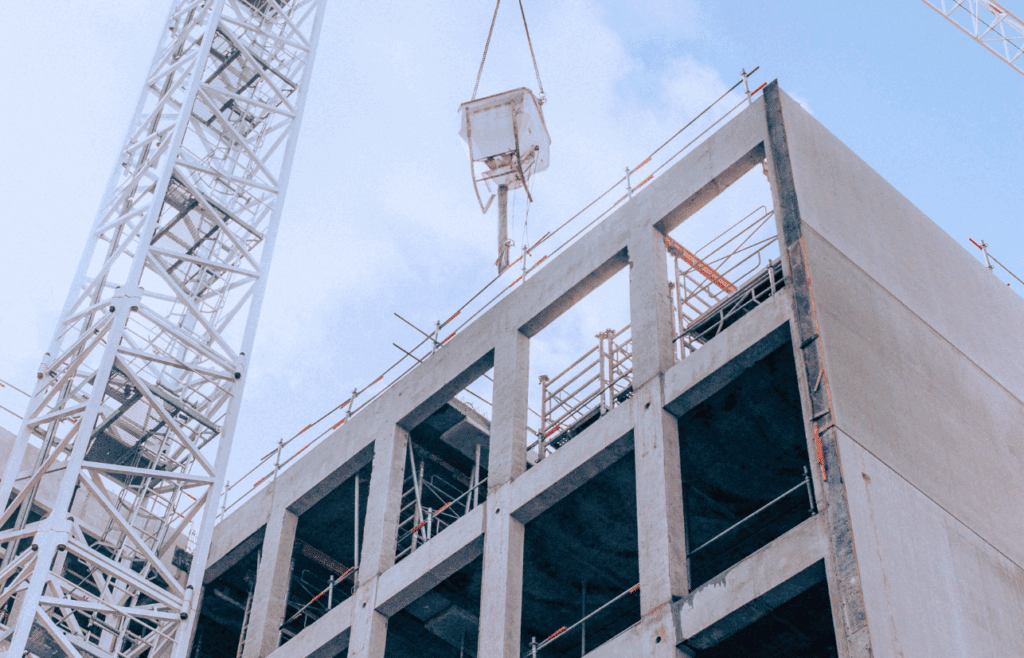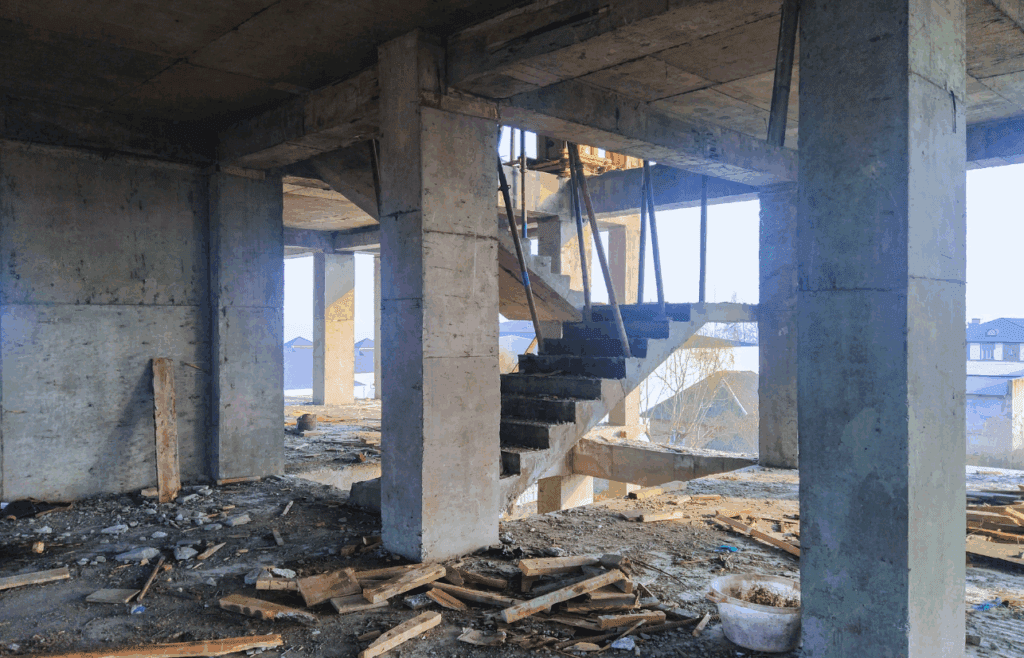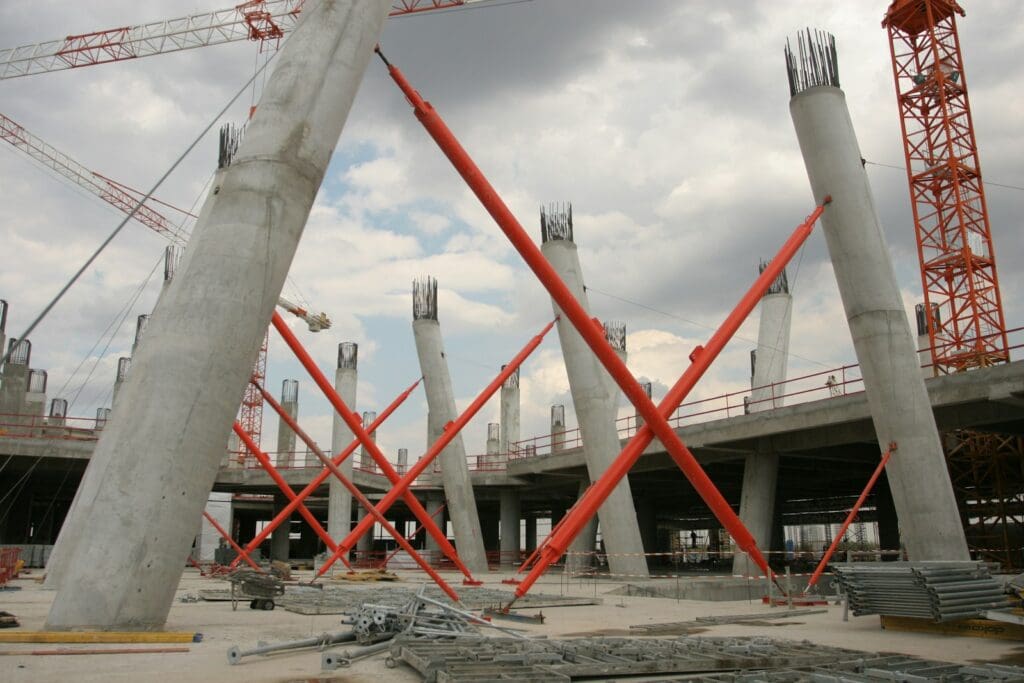Construction and Contracting: A Practical Guide for Australian Businesses
Construction doesn’t happen in a vacuum. Behind every site shed, concrete pour, variation, and inspection is a contract governing who’s responsible, what happens when things go wrong, and who gets paid. That contract is a legal document, and it’s also the framework that controls how the project runs from start to finish. Whether you’re a Principal, a Contractor, or a Subcontractor, you’re managing not just delivery, but risk. And the contract guides you in doing so.
This Guide is a practical resource for construction professionals across Australia. It’s been shaped by real disputes, real jobs, and real advisory work with businesses across every part of the sector. We don’t take theory and try to apply it to construction. We take what actually happens on projects and show you how the contract either supported the outcome—or didn’t.
Construction and Contracting intersect constantly. When work starts without signed scopes. When a Superintendent gives a verbal instruction. When a Subcontractor misses a QA hold point. These touchpoints determine whether the project finishes well—or ends in dispute. This Guide explains how to manage those touchpoints properly and gives a number of examples of our experience to illustrate the topics we discuss..

Key Takeaways
Learn how contract terms directly shape delivery outcomes across safety, time, quality, and payment
Understand where Construction and Contracting intersect—on-site, in documentation, and during dispute resolution
Implement role-specific strategies for Principals and Contractors to reduce exposure and improve control
Improve scope clarity, risk allocation, WHS compliance, programming, and close-out performance
Avoid disputes by enforcing variation, delay, and final claim procedures correctly and consistently
Adopt systems that align with legal rights under SOPA, WHS law, contract obligations, and project management best practice
Read real scenarios drawn from Blaze Business & Legal’s work advising and representing parties across the industry
Apply tested processes to your construction business—from procurement to defects management

1. Defining Project Scope and Delivery Methods
Scope is the most important part of any construction contract. It defines what’s included, what’s excluded, and how the work is expected to be delivered. If the scope is vague, everything downstream—pricing, programming, QA, payment claims—starts to break down. This leads to variations, delay claims, cost blowouts and strained relationships. The delivery method only adds complexity, particularly when it doesn’t match the actual risk allocation.
There are several common project delivery models in Australia—Construct Only, Design and Construct, Managing Contractor, EPC, and others. Each model carries different commercial and legal obligations, especially around design liability, latent conditions, programming, and Subcontractor engagement. Where we see most disputes is when a model is named in the contract, but the structure doesn’t follow it. That misalignment causes confusion about who does what, and when.
We recently advised a Contractor who signed up for a Design and Construct contract but had no control over final design documentation. Delays started early, and the Principal held the Contractor responsible. The Contractor argued design was incomplete—but the contract said otherwise. The delivery model didn’t reflect the actual responsibilities, and the dispute cost both sides significantly.
Scenario – Delivery Model Doesn’t Match Actual Responsibilities
Tips for Contracting and Construction
Tips for Principals
Match the delivery method to the project’s risk profile and complexity
Define scope line-by-line with clear inclusions, exclusions, and provisional items
Ensure risk-heavy responsibilities (e.g. design coordination, latent conditions) are contractually allocated
Confirm your design documentation is suitable for construction before tendering
Avoid reusing generic scopes from previous jobs—tailor them for each project
Tips for Contractors
Test the scope against delivery assumptions and available resources before pricing
Identify and document scope gaps and grey areas before signing the contract
Clarify who owns each design responsibility in D&C contracts
Make sure Subcontractor scopes align with head contract deliverables
Use your tender clarifications to record assumptions and exclusions
Action Step – For Principals
Audit your current scopes and delivery structures—if the contract doesn’t reflect the actual responsibilities, you’re likely heading for dispute.
Blaze Business & Legal can help you align contract terms, scopes, and delivery methods so that your legal and operational frameworks work together.
Action Step – For Contractors
Before accepting any contract, break down the scope against your internal resourcing, pricing, and program. If the documents don’t match, raise it immediately.
Blaze Business & Legal can help Contractors review tender documents and identify legal risks in delivery models before they impact your bottom line.
See our Related Articles
Choosing the Right Delivery Model for Construction Projects
Scope Gaps and Overlaps: A Contractor’s Guide to Risk Prevention
When Delivery Structure and Contract Terms Don’t Line Up

2. Risk Management Strategies in Construction Projects
Construction is one of the highest-risk commercial activities in Australia. Projects operate under tight timeframes, complex site conditions, multiple layers of subcontracting, and legal obligations that shift as the job progresses. Managing that risk isn’t just about having insurance or site procedures—it’s about allocating responsibility clearly, documenting it properly, and enforcing systems that reduce exposure when things go wrong.
Risk allocation starts in the contract. Who takes the hit for design errors? Who’s liable for latent conditions? What happens if the site floods during mobilisation? These aren’t theoretical questions—they’re real, recurring issues on jobs of every size. If the contract doesn’t deal with them clearly, they’re dealt with in dispute resolution, where outcomes are less predictable and far more expensive.
We often find that risk registers are created at the start of a project but never updated again. That’s a problem. If the delivery team doesn’t know how risk is allocated—or doesn’t monitor changes in risk as the project evolves—then every delay, variation, or incident becomes a potential claim. Risk isn’t something you hand off at tender stage. It’s something you manage actively throughout.
Scenario – Contractor Takes On Site Risk They Couldn’t Control
We assisted a Contractor who accepted a construct-only contract that included a blanket clause: “Contractor to inspect site and accept all conditions.” The site contained contaminated fill, which wasn’t disclosed in the tender documents. The Contractor was liable for removal and disposal at significant cost. The Principal argued the clause covered it. The dispute turned on whether the risk was reasonably foreseeable. The contract said one thing, but the operational reality said another.
Tips for Contracting and Construction
Tips for Principals
Define specific risks in the contract—don’t rely on catch-all clauses
Require tenderers to acknowledge major known risks in writing
Build risk-sharing mechanisms for high-value unknowns, such as latent conditions
Monitor delivery performance against the risk register, not just the program
Engage legal support to draft risk allocation clauses that hold up in disputes
Tips for Contractors
Maintain a live risk register from award through to final claim
Price risk properly—don’t assume you’ll recover unforeseen costs after the fact
Use contract clarifications to narrow or exclude unreasonable site or delivery risks
Track actual risk exposures on-site and escalate issues before they turn into claims
Review every contract clause that allocates liability for site, design, access or weather
Action Step – For Principals
Review how risks are allocated in your standard contracts—if you’re relying on broad or vague language, you’re increasing your exposure to disputes.
Blaze Business & Legal can help Principals develop enforceable, specific risk allocation frameworks that reflect actual project conditions.
Action Step – For Contractors
Map each contract clause to real delivery risks—if the wording doesn’t align with what’s happening on-site, raise the issue and record your position in writing.
Blaze Business & Legal works with Contractors to identify and manage high-risk terms before they become costly disputes.
See our Related Articles
Risk Allocation Clauses That Actually Work in Construction Contracts
How Contractors Can Limit Exposure to Unknown Site Conditions
What Should Be in Your Construction Risk Register—and Why It Matters

3. Legal and Regulatory Compliance in Construction Contracts
Legal compliance in construction is broad, strict, and constantly changing. It includes planning laws, building codes, safety regulations, licensing, environmental protections, and contract-specific obligations. Whether you’re a Principal or a Contractor, you can’t afford to treat compliance as background noise. Non-compliance stops work, voids insurance, leads to penalties, and creates liability that can’t be transferred once things go wrong.
Contracts often assume compliance will just “happen”—that Contractors will get the permits, that Subcontractors will follow WHS laws, and that site signage and safety systems will be sorted before anyone starts work. In reality, these items fall through the cracks when they’re not managed deliberately. We’ve seen multiple cases where Principal-side assumptions led to unapproved work and stop orders. We’ve also seen Contractors fail to engage licensed trades, leaving them legally and financially exposed.
The mistake we see most often is relying on memory and email trails to prove compliance. Council approvals, fire engineering certificates, waterproofing licences—these must all be documented, tracked and available. If your systems can’t produce these on demand, then you don’t have control over compliance, and neither does your insurer.
Scenario – Compliance Failure Leads to Site Shutdown and Legal Exposure
We advised a Contractor who had engaged a waterproofing Subcontractor based on a verbal assurance that licensing was current. It wasn’t. After works were completed, water ingress appeared. The Principal withheld payment. The Contractor couldn’t recover the cost because there was no subcontract, no licence record, and no compliance documentation. The Principal escalated the issue, and the Contractor carried full responsibility. It was preventable.
Tips for Contracting and Construction
Tips for Principals
Require statutory approvals and licences to be submitted before commencement
Verify Contractor and Subcontractor licences through public registers, not assumptions
Include compliance audits in project workflows—not just at Practical Completion
Ensure environmental approvals, development consents, and construction certificates are current and accessible
Keep a compliance matrix for every trade package, linked to contract milestones
Tips for Contractors
Build a compliance checklist at project start-up that includes all permits, licences, and approvals
Track renewal dates for licences, certifications, and insurances
Keep scanned records of compliance documents for each Subcontractor and trade
Make compliance part of toolbox talks and daily site briefings—not just admin
Establish internal sign-offs for compliance before claiming Practical Completion
Action Step – For Principals
Check whether your systems verify compliance documentation early in the job or just assume it’s been done by someone else.
Blaze Business & Legal can assist Principals in developing compliance tracking processes tied to contract deliverables and project risks.
Action Step – For Contractors
Audit your compliance documentation across active projects—if you can’t produce permits, licences and approvals quickly, you’re not covered.
Blaze Business & Legal can help Contractors build enforceable compliance systems that integrate with subcontracting and payment workflows.
See our Related Articles
What You’re Legally Required to Check Before Work Starts On Site
Construction Licensing and Insurance Failures That Lead to Claims
How to Avoid Regulatory Breaches That Void Your Contract

4. Payment Claims, Progress Payments and Cash Flow Control
Cash flow in construction doesn’t just keep businesses running—it determines whether a project survives. If payment claims are submitted late, incomplete, or in breach of contract requirements, disputes follow. If Principals fail to assess claims within statutory timeframes or without documented reasons, they can become liable for amounts they never intended to approve. The structure of payment under construction contracts is tightly regulated, especially in Security of Payment (SOPA) jurisdictions.
Payment issues are one of the most common sources of disputes. We’ve acted in matters where Contractors submitted claims for work that was only partially complete, or for variations that were never approved. We’ve also represented Contractors who were denied payment because the Principal failed to issue a Payment Schedule on time. Both sides have obligations—and failing to follow them correctly creates avoidable legal exposure.
The real risk lies in informal systems. Contractors who rely on spreadsheets and emails miss key deadlines. Principals who assess claims without clear workflows and documentation get caught in adjudications. If your payment process isn’t aligned with your contract and statutory obligations, your project—and your position—are vulnerable.
Scenario – Late Claim Submission Triggers Payment Rejection and Site Slowdown
We supported a Contractor who submitted a progress claim five days after the date specified in the contract. The Principal rejected the claim in full. Subcontractors weren’t paid, materials were delayed, and the project slowed significantly. When the Contractor resubmitted, the Principal issued a Payment Schedule with zero value, arguing that the work wasn’t claimed correctly. The delay wasn’t caused by a dispute over work—it was a failure in the Contractor’s claim system.
Tips for Contracting and Construction
Tips for Principals
Include clear payment claim dates, formats, and response timeframes in every contract
Implement internal SOPA-compliant workflows to ensure Payment Schedules are issued on time
Use checklists to assess progress claims against contract scope and supporting documentation
Track variations separately and confirm they’ve been approved before paying
Document reasons for rejection in writing—don’t rely on verbal feedback
Tips for Contractors
Maintain a live payment claim calendar linked to contract dates and site progress
Submit claims with full supporting evidence—photos, diaries, QA reports, Subcontractor invoices
Include a summary of previous claims and payments to show cumulative progress
Track unpaid variations and approved EOTs, and include them clearly in each claim
Follow up late payments formally and escalate based on contract dispute procedures
Action Step – For Principals
Review your internal payment review process—if you’re not tracking timelines or assessing claims against a checklist, you’re exposed under SOPA.
Blaze Business & Legal can help Principals design legally compliant assessment workflows that stand up in adjudication and reduce risk.
Action Step – For Contractors
Standardise your claim process using templates, calendars, and checklists—if you’re missing dates or relying on verbal updates, it’s only a matter of time before you lose money.
Blaze Business & Legal can assist Contractors in developing enforceable claim procedures that protect cash flow and limit disputes.
See our Related Articles
How to Submit Compliant Progress Claims Under SOPA
Principal Obligations When Assessing Construction Payment Claims
Claim Rejected? What You Can Do Under the Security of Payment Legislation

5. Managing Delays, Extensions of Time (EOTs) and Liquidated Damages
Delays happen on every construction project. But how they are handled determines whether the party responsible is legally liable—or contractually protected. Extension of Time (EOT) clauses and Liquidated Damages (LDs) aren’t just legal tools—they’re central to how time risk is managed. If the right processes aren’t followed, a delay becomes a dispute. If documentation is weak, even a legitimate claim can be denied.
For Principals, the risk is applying LDs without properly assessing the EOT claim or without maintaining accurate records of delays and responses. For Contractors, the risk lies in submitting EOTs late or without linking the delay to the critical path. Disputes arise not from the delay itself, but from procedural failures. Contracts almost always set out the EOT process—but in many cases, neither party follows it correctly.
We’ve worked with dozens of Contractors who assume they’ll get more time just because a delay was outside their control. But unless the contract conditions are met—written notice, program updates, substantiation—the EOT will be rejected. On the other side, we’ve seen Principals lose the right to apply LDs because they failed to assess an EOT at all.
Scenario – EOT Rejected After Contractor Misses Notice Deadline
We advised a Contractor who encountered wet weather and access delays. The delay was legitimate, but the EOT notice was issued three days after the period required under the contract. The Principal rejected it, applied LDs, and the Contractor couldn’t enforce their claim. Even though the works were clearly delayed due to weather, the procedural failure prevented any recovery.
Tips for Contracting and Construction
Tips for Principals
Set clear EOT notice timeframes and enforce them strictly
Require all EOT claims to reference the latest program and delay cause
Maintain records of site conditions, Superintendent directions, and access issues
Assess each EOT with documented reasons and link to critical path impact
Avoid applying LDs unless the EOT process has been properly followed
Tips for Contractors
Track all potential delay events daily and issue notices promptly—even if the delay continues
Link EOT claims to specific program activities and show time impact clearly
Submit updated programs showing new completion dates with each EOT
Keep a delay register that records weather, access, variations, and site restrictions
Don’t rely on verbal approvals—always submit formal notices in writing
Action Step – For Principals
Check whether your delay assessment process includes timeframes, criteria, and a documented review method—if not, you may lose the right to apply LDs.
Blaze Business & Legal can assist Principals with creating EOT and LD procedures that stand up under contract and legislation.
Action Step – For Contractors
Audit your EOT notices and delay tracking system—if you’re not issuing timely, documented claims, you’ll miss entitlements even when you’re not at fault.
Blaze Business & Legal helps Contractors build EOT workflows that comply with contracts and support defensible claims.
See our Related Articles
How to Structure a Compliant EOT Claim
Liquidated Damages: When Can They Be Enforced—and When Can’t They?
The Danger of Time at Large in Construction Projects

6. Site Establishment and Mobilisation
The mobilisation phase is where contracts meet reality. It’s the point where the Contractor takes possession of site, insurance risk shifts, Temporary Works are implemented, and program time begins. If this handover is unstructured or rushed, delays, safety breaches, and access issues follow. Mobilisation is not just about turning up—it’s a legal and operational milestone that needs planning, documentation, and control.
Site establishment includes setting up site fencing, amenities, signage, temporary services, laydown areas, and environmental controls. But the contractual impact runs deeper. Mobilisation often triggers payment entitlements, Practical Completion timeframes, and WHS obligations. If these triggers are met without the right checks, both parties are exposed. We’ve seen Contractors start work before site access is legally granted, and Principals fail to define what “possession of site” means in the contract.
Mobilisation is also where errors become embedded. If the site setup fails to meet contractual conditions or regulatory approvals, rework, delay and compliance breaches follow. The best-managed projects treat mobilisation like a handover ceremony—with checklists, site readiness reviews, and documented responsibilities between the Principal and Contractor.
Scenario – Site Access Delayed Due to Incomplete Principal Works
We advised a Contractor who arrived to establish site and begin work, only to find the Principal had not completed enabling works—specifically, the agreed access road was unfinished. No extension of time was granted, as the contract had vague possession clauses. The Contractor incurred costs for idle plant and subcontractors. The dispute could have been avoided with clearly defined possession terms and staged access documentation.
Tips for Contracting and Construction
Tips for Principals
Define possession of site in the contract—including specific conditions that must be met first
Require Contractors to submit mobilisation plans for review before the access date
Include early works, access roads, and enabling works in your own delivery obligations
Establish documentation, safety and signage requirements as part of site readiness
Confirm site boundaries, access points, and public interfaces before granting possession
Tips for Contractors
Prepare a mobilisation checklist covering WHS, Temporary Works, fencing, plant, and signage
Confirm in writing that possession of site has occurred and that site conditions are compliant
Factor mobilisation time into your program, including lead times for amenities and services
Coordinate environmental controls and safety signage before site works begin
Document all pre-start meetings, inspections and agreements about staging and access
Action Step – For Principals
Check whether your site possession process includes defined conditions, access requirements, and enabling works responsibilities—if it doesn’t, disputes will surface early.
Blaze Business & Legal can help Principals draft possession clauses and pre-mobilisation checklists that lock in your legal position before works commence.
Action Step – For Contractors
Create a mobilisation package for every new project—including site setup, compliance records, access planning and early subcontractor scheduling.
Blaze Business & Legal assists Contractors in documenting mobilisation rights and creating enforceable notices if the site is not ready.
See our Related Articles
Possession of Site: Legal and Operational Triggers You Can’t Miss
Site Establishment Delays: Who Pays and How to Avoid It
Mobilisation Checklists That Prevent Project Disputes

7. Workplace Health and Safety (WHS)
WHS in construction is non-negotiable. It’s not just a regulatory requirement—it’s a key part of the contract. Whether you’re a Principal or a Contractor, your safety systems, documentation, and onsite controls have legal and commercial consequences. Poor WHS management leads to project shutdowns, personal liability, and in some cases, prosecution. When an incident occurs, the first thing regulators ask for is the paperwork. If it doesn’t exist or doesn’t reflect what’s happening on-site, you’re exposed.
Construction sites must have site-specific WHS Management Plans, Safe Work Method Statements (SWMS), daily pre-starts, and evidence of ongoing consultation. Many contracts now tie WHS performance to milestone payments and even contract continuation. But despite this, too many Contractors and Subcontractors treat safety documentation as static—created at project start, then ignored.
We’ve worked with clients where a Subcontractor incident exposed every party upstream. Even when the head contract required compliance, the Principal had no way to audit or enforce it, and the Contractor had no real-time records. If your contract requires WHS compliance, then your systems must prove that compliance at all times.
Scenario – Subcontractor Incident Leads to Contractor and Principal Exposure
We advised a Principal after a Subcontractor suffered a serious injury on-site. The Subcontractor’s SWMS was outdated. The Contractor hadn’t checked it. The Principal had no audit records. SafeWork launched an investigation. Liability didn’t stop at the Subcontractor—it extended up the chain. The Principal had assumed compliance would be managed by the Contractor, but their contract didn’t include any rights to audit or enforce it.
Tips for Contracting and Construction
Tips for Principals
Include WHS compliance and audit rights in your contract with the head Contractor
Require site-specific WHS Management Plans to be submitted and approved pre-start
Track implementation of safety systems through documented inspections and reports
Require Subcontractor inductions, licences and SWMS as part of project mobilisation
Include safety performance as a metric in progress payments and contract reviews
Tips for Contractors
Review Subcontractor WHS documentation regularly—not just at site start
Keep a real-time SWMS register and update it whenever methods or conditions change
Run toolbox talks and pre-starts that reflect actual risks on-site
Assign one person to be responsible for WHS compliance tracking and records
Store incident reports, inspection results, and safety briefings centrally for audit
Action Step – For Principals
Review your current contracts and WHS systems—if you can’t show how you verify safety on-site, you may be legally liable even if others were at fault.
Blaze Business & Legal helps Principals draft contracts that assign responsibility for WHS while preserving enforceable oversight rights.
Action Step – For Contractors
Create a WHS evidence pack for every active project that includes site-specific plans, licences, inspection records, and daily updates.
Blaze Business & Legal can assist Contractors in aligning safety systems with contract requirements and protecting against liability when incidents occur.
See our Related Articles
Who’s Liable When Safety Fails? The Contract Says More Than You Think
What Your WHS Management Plan Needs to Contain
Subcontractor Safety Compliance – What You Must Verify Before Work Starts

8. Quality Assurance and Defects Management
Quality Assurance (QA) and Defects Management are not the same process. QA is proactive—it prevents defects by defining and monitoring construction standards throughout the project. Defects Management is reactive—it deals with issues after they occur. Contracts often treat these as one function, but they need separate systems, responsibilities, and documentation. If the QA process is weak, Defects Management becomes more expensive and more contentious.
Quality Assurance involves Inspection and Test Plans (ITPs), trade benchmarks, hold points, and sign-offs. It’s where the Contractor proves compliance with project specs as the work is performed—not afterwards. Principals often assume QA is under control because a Contractor has submitted an ITP. But that ITP is only useful if it’s followed, updated, and signed off in real time. We regularly advise on disputes where the paperwork exists but the inspections didn’t happen—or happened too late.
Poor QA results in rework, cost blowouts, delayed Practical Completion, and loss of trust between parties. It also undermines final payment claims and creates uncertainty over what’s been finished properly. QA must be part of delivery—not just a set of documents prepared at project start.
Scenario – Incomplete QA Documentation Delays Practical Completion
We worked with a Principal who refused to certify Practical Completion because the Contractor failed to provide completed ITPs for fire-rated wall systems and waterproofing. The work was done—but the documentation wasn’t. The Contractor argued the installations met spec. The Principal wanted proof. The delay cost two weeks of occupancy and triggered further payment issues. All of it was avoidable.
Tips for Contracting and Construction
Tips for Principals
Require ITPs for high-risk trades and ensure hold points are contractually enforceable
Verify that QA inspections are being performed—not just planned
Include QA sign-offs in progress claim prerequisites for major trades
Engage independent inspectors or a Superintendent to verify compliance
Make Practical Completion contingent on full QA documentation being delivered
Tips for Contractors
Assign a QA coordinator responsible for ITPs, inspections, and defect prevention
Use photo evidence to confirm compliance before covering up critical works
Include QA checklists in every Subcontractor package
Keep digital copies of all QA sign-offs, benchmarks, and hold point approvals
Flag any QA issues immediately and log rectification work clearly
Action Step – For Principals
Check whether your QA systems are focused on real inspections and sign-offs—not just paperwork handed in at the end.
Blaze Business & Legal can assist Principals in enforcing QA compliance through contract clauses and Superintendent engagement.
Action Step – For Contractors
If your QA documents are completed after the fact or missing key evidence, you’re risking payment and credibility.
Blaze Business & Legal can help Contractors integrate QA procedures that meet both operational and contractual standards.
See our Related Articles
What a Good ITP Looks Like—and Why It Matters
QA Compliance Failures That Lead to Defects Claims
Linking QA Documentation to Practical Completion
Defects Management
Once work reaches Practical Completion, the focus shifts from delivery to accountability. The Defects Liability Period begins, and with it, the obligation to rectify any issues that arise. The process is often misunderstood. Some Contractors think the clock resets with every defect. Some Principals believe they can withhold final payment indefinitely until they’re satisfied. The truth lies in the contract—and in how defects are managed, not just identified.
Defects must be recorded, notified, and rectified within specified timeframes. Most standard contracts require the Principal to issue a Defects Notice, triggering a defined rectification period. But if no register exists, or if items aren’t tracked, both parties lose visibility. We’ve seen Principals forget to issue notices, and Contractors fail to act on them—resulting in escalations that were entirely avoidable.
The other major issue is latent defects—those that arise after the defects liability period has expired. Without proper QA and close-out documentation, Contractors find themselves exposed to claims years later.
Scenario – Contractor Sued for Latent Defects After Defects Period Ends
A Principal came to us after discovering water ingress 18 months after Practical Completion. The defect related to poor sealing of penetrations in a wet area wall. The Contractor argued the defect period had expired. The Principal pointed to poor QA records and latent defect provisions in the contract. The Contractor had no inspection photos or sign-offs. The claim progressed and became a significant financial burden.
Tips for Contracting and Construction
Tips for Principals
Maintain a defects register with photos, issue dates, rectification status, and close-out confirmations
Issue formal notices when defects are identified and track contractor responses
Tie final security release to completion of all listed defects—not just timeframes
Schedule inspections during and at the end of the defects period
Keep a record of communication and workmanship issues flagged during construction
Tips for Contractors
Respond to defect notices in writing and log each rectification action
Maintain a separate latent defects tracker with site photos and design clarifications
Appoint a team or supervisor to manage defects resolution during the liability period
Document defect completion and obtain written confirmation from the Principal or Superintendent
Store all rectification records with your close-out documentation for future protection
Action Step – For Principals
Audit how you currently manage defect identification, communication, and closure—if your systems are informal, you’re increasing risk.
Blaze Business & Legal can help Principals implement formal Defects Management processes linked to payment and security release triggers.
Action Step – For Contractors
Create a system for tracking and responding to all defect notices—include timelines, documentation, and rectification photos.
Blaze Business & Legal can assist Contractors in limiting post-completion liability through enforceable documentation and response procedures.
See our Related Articles
Managing the Defects Liability Period Under Construction Contracts
Latent Defects: What They Are and How to Protect Against Them
Securing Final Payment Without Being Held Hostage to Defects

9. Practical Completion and Handover
Practical Completion is the most contested milestone in most construction contracts. It’s where the delivery team says the job is done, but the Principal often disagrees. It’s also where the legal and financial dynamics of the project shift—liability for Liquidated Damages stops, the Defects Liability Period begins, and final claims and retention release timeframes kick in. Getting this milestone wrong causes delay, cash flow disruption, and legal exposure.
Contracts define Practical Completion differently, and many fail to include objective, measurable criteria. Without a checklist of what constitutes completion, both sides rely on opinion. That leads to inconsistent decisions by Superintendents, strained Contractor-Principal relationships, and risks of dispute or adjudication. Handover is not about whether the work looks finished—it’s about whether the documentation, testing, and compliance obligations have been satisfied.
We often assist with disputes that stem from unclear or incomplete handover documentation. The most common trigger is a Contractor claiming completion without O&M manuals, commissioning certificates, or evidence of user training. Principals then withhold certification, which delays final payments and extends liability. This is preventable with clear contract terms and consistent systems.
Scenario – Contractor Denied Practical Completion Due to Missing Documentation
We acted for a Contractor who claimed Practical Completion on a commercial fit-out project. The physical works were done, but the fire safety certificates and commissioning documents were incomplete. The Principal withheld certification. Because the contract defined completion as “subject to receipt of all compliance documents,” the delay was enforceable. The Contractor waited six weeks for final payment and was exposed to LDs in the meantime.
Tips for Contracting and Construction
Tips for Principals
Define Practical Completion in the contract with specific document and compliance deliverables
Require submission of O&M manuals, test reports, commissioning certificates, and training logs
Involve end users or facilities managers in final walkthroughs to confirm operational readiness
Establish a clear inspection and certification workflow with timeframes
Refuse to accept Practical Completion without all required close-out documents in hand
Tips for Contractors
Build your handover documentation as you go—not just at the end
Include Practical Completion readiness checks in your internal program
Request certification in writing and include a full list of completed deliverables
Track and follow up on certificates from Subcontractors and consultants early
Keep a copy of all handover documentation in a single, organised location
Action Step – For Principals
Check whether your contract and handover process are built around objective completion criteria—or whether you’re relying on a Superintendent’s discretion.
Blaze Business & Legal can help Principals enforce clear completion standards and documentation requirements to avoid unnecessary disputes.
Action Step – For Contractors
Prepare a close-out and handover plan for every project, linked to your Practical Completion claim and program milestones.
Blaze Business & Legal can assist Contractors in ensuring your handover process meets all contractual conditions and gets you certified and paid.
See our Related Articles
What Does Practical Completion Really Mean?
Document Checklists for Construction Handover
Why Principals Should Never Certify Without the Paperwork

10. Retention, Security and Final Claims
Retention and security mechanisms exist to protect the Principal against incomplete work, defects, or unfulfilled contractual obligations. But when these mechanisms are poorly understood or misapplied, they quickly turn into flashpoints for dispute. Contractors often see retention as unfairly withheld. Principals see it as their only protection once work is complete. The contract governs how retention is held, released, and enforced—but only if both parties follow the rules.
Retention is commonly 5% of the contract sum, deducted from progress claims, with half released at Practical Completion and the balance after the Defects Liability Period. But many contracts differ. Some require security in the form of bank guarantees or insurance bonds. If these rules aren’t clearly documented or followed, the final stage of the project becomes adversarial—just when both sides should be closing out and moving on.
Final claims are also a high-risk area. Contractors submit their last invoice expecting payment, but find it withheld due to alleged defects, undocumented variations, or administrative non-compliance. Principals sometimes withhold funds without a valid contractual reason, exposing themselves to SOPA claims or formal dispute. We’ve helped both sides navigate this process and the solution is always the same—get the process right, early.
Scenario – Final Claim Rejected After Principal Withholds Retention Without Notice
We worked with a Contractor who submitted a final claim including the remaining retention funds. The Principal rejected it, citing “pending defects,” but had not issued a formal defect notice or itemised the issues. The contract required written reasons for non-payment. Because the Principal didn’t comply, the Contractor launched a SOPA claim and recovered the retention in full. The outcome could’ve been avoided with better process on both sides.
Tips for Contracting and Construction
Tips for Principals
Define the form, timing, and release conditions for retention and security in the contract
Track all deductions clearly and provide itemised statements with each claim assessment
Don’t withhold retention or final payment unless you’ve followed the notice requirements
Use documented defect notices to justify withholding—not generic objections
Avoid relying on informal communications to explain payment decisions
Tips for Contractors
Keep a real-time register of retention held and expected release dates
Submit your final claim with all required documentation and a reconciliation of prior payments
Follow up final claim assessments in writing and respond formally to any rejections
Reserve your rights in writing if you disagree with the final assessment
Make sure security instruments (bank guarantees, bonds) are tracked and expired properly
Action Step – For Principals
Review how your retention and security obligations are documented and enforced—if you’re withholding funds without following the contract, you’re increasing your legal risk.
Blaze Business & Legal can help Principals set up enforceable retention processes and defensible payment workflows that limit disputes.
Action Step – For Contractors
Build a structured final claim procedure that includes tracking retention, final payments, and defect close-out before submission.
Blaze Business & Legal helps Contractors prepare final claims that comply with contract conditions and stand up in adjudication if challenged.
See our Related Articles
Retention Clauses That Work – Without Leading to Payment Disputes
What Contractors Must Include in Their Final Claims
Withholding Final Payment – What the Contract Allows (and What It Doesn’t)

11. Managing Variations and Scope Changes
Variations are inevitable. Whether due to design changes, site conditions, regulatory requirements or client preferences, construction projects rarely finish exactly as planned. But variations are also one of the most disputed elements of a contract. Contractors often perform extra work assuming payment will follow. Principals often reject claims due to lack of instruction, documentation or pricing agreement. The result—unpaid work, delayed programs, and legal escalation.
Variations must follow the procedure in the contract. Most require written instructions from the Superintendent or Principal, a formal variation proposal, documented acceptance, and clear pricing. Contractors who skip these steps take on significant financial risk. Principals who approve variations informally often find themselves bound by those approvals—even when the paperwork doesn’t exist. We’ve advised on both sides of this situation, and the lesson is always the same—don’t skip the process.
Scope changes can also trigger programming issues, EOT claims, and Subcontractor confusion if not managed properly. When the contract doesn’t match what’s happening on site, costs escalate. Variations aren’t just about money—they’re also about time, compliance, and delivery method. Every variation needs to be priced, assessed, and documented to protect all parties.
Scenario – Verbal Instruction Results in Unpaid Variation and SOPA Claim
We acted for a Contractor who carried out additional concrete works based on verbal instructions from the site Superintendent. The Superintendent later left the project, and the Principal refused to pay. There was no written direction or approval. The Contractor issued a SOPA claim but lost in adjudication due to lack of evidence. The work was done, but the contract wasn’t followed—and payment was denied.
Tips for Contracting and Construction
Tips for Principals
Require all variations to be submitted in writing with detailed pricing and justification
Only issue written variation directions—never rely on verbal approvals
Track approved variations in a live register and cross-reference with progress claims
Confirm Superintendent authority and document approvals consistently
Avoid accepting unpriced or open-ended variation claims
Tips for Contractors
Never commence variation works without a written direction or documented instruction
Break down pricing to show labour, materials, plant, overheads, and margin
Track all variation submissions and approvals in a project register
Include EOT implications with every variation that impacts time
Keep site records, photos, and meeting notes that link the variation to delivery
Action Step – For Principals
Review your internal controls around issuing variation directions—if staff are giving verbal instructions, you’re increasing financial risk.
Blaze Business & Legal can help Principals implement variation systems that protect budgets and enforce contract compliance.
Action Step – For Contractors
Formalise your variation request process with templates, registers and escalation pathways—don’t rely on informal approvals.
Blaze Business & Legal assists Contractors in preparing enforceable variation claims that comply with contract conditions and support payment recovery.
See our Related Articles
Variation Procedures That Keep Projects on Track
The Legal Risk of Verbal Instructions in Construction
How to Price and Submit Variations Without Getting Rejected

12. Subcontractor Engagement and Management
Subcontractors are critical to delivering construction projects on time, to spec, and within budget. But they also introduce significant contractual and delivery risk. Most Contractors rely on dozens—sometimes hundreds—of Subcontractors over the life of a project. When those relationships are not governed by clear scopes, enforceable agreements, and structured oversight, defects, delays, and legal issues quickly follow.
Engaging Subcontractors isn’t just about getting the cheapest price. It’s about aligning their scope, obligations, and timing with your head contract. If a Subcontractor isn’t legally bound to meet your delivery targets, your entire program is exposed. If their insurance or licensing doesn’t meet your requirements, you carry the liability. We’ve advised Contractors whose defaulting Subcontractors caused EOT disputes, QA failures, and even project-wide shutdowns. The issue wasn’t just performance—it was poor contract management.
Another key risk is downstream misalignment. If you sign a lump sum head contract but issue cost-plus subcontracts, or forget to flow down EOT and variation conditions, your contractual chain breaks. Principals are not concerned with who caused the problem—they look to the Contractor. And without proper Subcontractor control, the blame lands squarely on your side.
Scenario – Misaligned Subcontract Triggers Delay and Liquidated Damages
We supported a Contractor who engaged a roofing Subcontractor using a short-form agreement with no program obligations. When the roof installation was delayed by four weeks, the Principal imposed LDs under the head contract. The Contractor tried to pass this on, but the subcontract had no enforceable dates, no EOT provisions, and no delivery milestones. The loss sat entirely with the Contractor—because the paperwork didn’t match the risk.
Tips for Contracting and Construction
Tips for Principals
Require head Contractors to provide copies of all executed subcontracts for major trades
Include rights to audit Subcontractor compliance with licensing, insurance, and WHS
Ensure performance obligations flow from the head contract through to key Subcontractors
Prohibit use of informal or purchase-order-based Subcontractor engagements
Document who is responsible for Subcontractor default and recovery procedures
Tips for Contractors
Use properly drafted subcontracts—not quotes or scope emails—to engage every Subcontractor
Flow down key head contract terms, including EOT rights, delay damages, and safety obligations
Track Subcontractor performance weekly—not just at milestones or after problems occur
Retain control of procurement scheduling, QA, and progress tracking for all trades
Keep a register of subcontract scopes, terms, and compliance documents
Action Step – For Principals
Audit your head contract templates—if you don’t require transparency over Subcontractor arrangements, you may be taking on more risk than intended.
Blaze Business & Legal helps Principals draft contract terms that give structured oversight of Subcontractor compliance and performance.
Action Step – For Contractors
Standardise your Subcontractor engagement process—using consistent scopes, flow-down terms, and documentation across all trades.
Blaze Business & Legal assists Contractors in creating enforceable subcontracts that align with the head contract and reduce downstream exposure.
See our Related Articles
How to Write a Subcontract That Actually Protects You
What to Include in Every Subcontractor Engagement Checklist
Aligning Subcontractor Obligations With Your Head Contract

13. Program Management and Critical Path Control
Program management isn’t just about scheduling—it’s about legally managing time, sequencing work, and proving entitlement. Under most construction contracts, the program is not just a delivery tool, but a contractual obligation. It determines whether delays are compensable, whether an Extension of Time (EOT) is granted, and whether the Contractor is exposed to Liquidated Damages. Yet too many projects treat the program as a set-and-forget document.
The critical path—the sequence of activities that directly impact completion—is central to delay assessments and risk management. If the program doesn’t accurately reflect this path, or if it isn’t updated when changes occur, both Principals and Contractors lose visibility. That’s when disputes arise over who’s responsible for delays, whether float has been consumed, and whether the Contractor is entitled to more time.
A common failure we see is the lack of program logic updates. For example, the Contractor submits a baseline program at the start of the project but never updates it to reflect actual progress, variations, weather events, or access delays. Then, when an EOT claim is made, there’s no documented link between cause and impact. The claim fails—not because it wasn’t valid, but because it wasn’t proven.
Scenario – EOT Claim Rejected Due to Outdated Program
We advised a Contractor who submitted an EOT for material delivery delays affecting a major structural element. However, the program hadn’t been updated in three months and didn’t reflect the new sequencing or prior EOTs. The Superintendent argued the delay wasn’t on the critical path. With no updated program and no clear logic, the Contractor lost the claim and was hit with over $100,000 in LDs. The lesson: outdated programs kill claims.
Tips for Contracting and Construction
Tips for Principals
Require baseline and updated programs to show critical path and float clearly
Set program update intervals (e.g. monthly) in the contract and enforce them
Use program reviews to anticipate delays—not just respond to claims
Ensure the Superintendent reviews each update formally and provides written feedback
Cross-check EOT claims against the latest approved program and site records
Tips for Contractors
Maintain a live program with all EOTs, variations, and sequencing changes reflected
Use programming software that captures logic, float, and dependencies accurately
Link delay notices and EOT claims directly to affected activities on the critical path
Update the program after every approved variation or major site event
Include a narrative with each submission explaining what changed and why
Action Step – For Principals
Evaluate your current process for reviewing Contractor programs—if you’re not assessing updates or tracking logic, you’re limiting your ability to manage time-related risks.
Blaze Business & Legal helps Principals formalise program review procedures and align them with contract time obligations.
Action Step – For Contractors
Implement a system for updating and submitting your program that ties directly to EOT claims and Superintendent review cycles.
Blaze Business & Legal assists Contractors in making time-related claims that are supported by compliant, updated programming documentation.
See our Related Articles
How to Link Delay Events to Critical Path in EOT Claims
Construction Program Obligations: What the Contract Actually Requires
The Cost of Failing to Update Your Project Schedule

14. Communications and Project Meetings
Effective communication underpins every successful construction project. It shapes how decisions are made, how risks are escalated, and how claims are resolved. But despite its importance, communication is one of the most poorly managed elements on site. Verbal instructions go undocumented, meeting minutes aren’t circulated, and formal notices are either missed or non-compliant. When these failures happen, contract rights are lost.
Most construction contracts require notices for things like delays, variations, site conditions, and payment disputes. They also specify how those notices must be delivered—by whom, when, and in what form. But in practice, teams default to informal conversations and loose email trails. When disputes arise, the absence of formal written records weakens both parties’ legal positions. We’ve seen Contractors lose payment claims because they didn’t submit notices in the correct format, and Principals caught off guard by undocumented instructions that became binding.
Project meetings, particularly site coordination and Superintendent meetings, are critical. They often become the place where directions are issued, progress is measured, and disputes begin to form. If meeting minutes aren’t agreed and shared, they become legally meaningless. If actions from those meetings aren’t followed up, the same problems repeat across the program.
Scenario – Verbal Variation Instruction Disputed Months Later
We represented a Contractor who received a verbal instruction during a site meeting to proceed with out-of-scope electrical works. No written direction followed. The work was completed, and the Contractor submitted a variation claim three months later. The Superintendent denied it, saying no variation had ever been authorised. Without meeting minutes, a written instruction, or follow-up correspondence, the Contractor had no evidence—and the claim failed.
Tips for Contracting and Construction
Tips for Principals
Require formal agendas and signed minutes for all project meetings
Direct your team and Superintendent to issue instructions only in writing
Include communication protocols in the contract—not just the delivery schedule
Train project managers on what constitutes a formal direction under the contract
Review all outgoing correspondence for clarity, compliance and contractual language
Tips for Contractors
Confirm every verbal instruction in writing—same day, by email, referencing the date and meeting
Maintain a notice register for EOTs, delays, claims and directions
Assign responsibility for correspondence tracking to a site administrator or contract manager
Store all site memos, Superintendent directions and meeting minutes in one central system
Include a ‘communications received’ checklist in your progress claim submissions
Action Step – For Principals
Audit how directions and communications are being issued on your projects—if your team is giving verbal instructions, you’re assuming legal liability without control.
Blaze Business & Legal can assist Principals with developing compliant communication protocols and standard templates for formal instructions.
Action Step – For Contractors
Implement a formal communication workflow—linking notices, meeting minutes, and Superintendent directions to your claims and delay registers.
Blaze Business & Legal helps Contractors create enforceable correspondence procedures that support payment and delay claims.
See our Related Articles
Verbal Instructions in Construction – What’s Legally Enforceable?
The Role of Notices Under Australian Construction Contracts
Project Meeting Minutes: Legal Weight and Practical Use

15. Project Close-Out and Final Certification
Project close-out is where construction and contracting meet for the final time. It’s not just about ticking off punch lists—it’s the legal handover of the project and the point where entitlements and liabilities are locked in. Poor close-out processes delay final certification, block retention release, and open up parties to disputes over incomplete works, unresolved defects, or missing documentation.
For Principals, the challenge is certifying completion when documentation is unclear or inspections haven’t been properly carried out. For Contractors, the risk lies in assuming that the work is finished just because the physical works are done. The contract often requires test results, warranties, commissioning records, O&M manuals, and training logs before final certification can be issued. Without these, Practical Completion and Final Completion are legally and commercially stalled.
We’ve seen projects where Contractors completed all works but failed to deliver the required paperwork. As a result, retention was withheld and the Defects Liability Period was never formally triggered. That kind of delay doesn’t just affect cash flow—it also leaves both parties exposed if latent issues arise down the track.
Scenario – Contractor Denied Final Certification Due to Missing Test Reports
We advised a Contractor who submitted their final claim expecting certification and release of retention. The Principal refused to certify because two fire safety test reports were missing. The works had been performed, but the Superintendent’s assessment was clear: no certification without the complete set of compliance documents. The Contractor eventually recovered payment—but only after a three-month delay and formal dispute resolution process.
Tips for Contracting and Construction
Tips for Principals
Include detailed close-out requirements in the contract—including document checklists and performance tests
Require certification submissions as part of Practical Completion and again at Final Completion
Link release of retention and security to delivery of specific, listed documents
Don’t rely on site inspections alone—verify that documentation aligns with actual performance
Schedule final walkthroughs with a checklist and independent sign-off where required
Tips for Contractors
Begin preparing close-out documentation months before Practical Completion
Maintain a checklist of all required certificates, warranties, and manuals throughout the job
Submit documentation in a single indexed pack for ease of review
Follow up Superintendent responses formally and document delays in issuing certification
Retain digital copies of all handover material and track version control
Action Step – For Principals
Review how final certification is triggered on your projects—if it relies on an ad hoc decision or informal checklist, you’re creating unnecessary delay and risk.
Blaze Business & Legal can help Principals develop enforceable close-out processes that align with contract terms and payment milestones.
Action Step – For Contractors
Build a close-out pack template for each project that includes all contractually required items—prepare it well before the last site meeting.
Blaze Business & Legal assists Contractors in finalising claims, satisfying certification conditions, and triggering timely payment and security release.
See our Related Articles
What Final Certification Requires Under Most Standard Construction Contracts
Retention Release: What Must Be Delivered Before You Get Paid
Closing Out a Project Without Triggering a Dispute

Conclusion
Construction and Contracting work in tandem from project inception to close-out. Every decision on-site, every payment made, every delay managed is shaped by the contract. Whether you’re a Principal, a Contractor, or a Subcontractor, your success depends on how well you navigate this relationship. It’s not enough to build well. You need to contract well, document consistently, and act within the framework you’ve agreed to.
We’ve advised businesses across all parts of the construction sector. We’ve helped Contractors recover unpaid claims, assisted Principals in enforcing defect rectification, and supported both sides during adjudications that came down to who kept better records. In every case, the outcome turned not just on what happened—but on what was documented, communicated, and contractually compliant.
This Guide is based on the hundreds of issues we’ve resolved for real businesses across Australia. Construction and Contracting are practical, commercial, and time-sensitive. And the businesses that succeed are the ones who align delivery with documentation, who know where their risks sit, and who respond early—before issues become disputes.
If that’s how you want to run your business, this Guide is your blueprint. If you need help making it happen, that’s where we come in.

FAQs
1. What’s the difference between Construction and Contracting?
Construction refers to the physical delivery of building works, while Contracting refers to the legal framework that governs that delivery through rights, obligations, and risk allocation.
2. How can Principals avoid disputes with Contractors?
Principals can avoid disputes by defining scope clearly, enforcing notice procedures, tracking delays and variations properly, and following formal certification and payment workflows.
3. What should a Contractor look for before signing a contract?
A Contractor should look for scope clarity, risk clauses, EOT conditions, retention terms, program obligations, and whether Subcontractor rights are properly aligned with the head contract.
4. How does a variation become enforceable?
A variation becomes enforceable when it follows the contract procedure, including written instruction, detailed pricing, documented approval, and clear linkage to time and cost impacts.
5. What is the critical path and why does it matter?
The critical path is the sequence of project tasks that directly determines the completion date. Any delay to these tasks can delay the entire project, making them essential for EOT claims.
6. When does Practical Completion occur under a contract?
Practical Completion occurs when all contractually required works (and documentation) are complete, except for minor omissions that do not prevent occupation or use of the works.
7. How are Liquidated Damages calculated and enforced?
Liquidated Damages are pre-agreed amounts payable for each day of delay beyond the contract completion date, enforceable only when the delay is not covered by a valid EOT.
8. What should be included in a Subcontractor agreement?
A Subcontractor agreement should include scope, program obligations, payment terms, retention, WHS compliance, defect rectification, and flow-down provisions from the head contract.
9. What happens if a final claim is rejected?
If a final claim is rejected, the Contractor may pursue it through SOPA, formal dispute resolution, or negotiation—but only if they’ve submitted it correctly and followed the contract process.
10. Can a Principal withhold retention without notice?
A Principal cannot lawfully withhold retention without issuing a valid notice in accordance with the contract, particularly if the retention release is linked to completed obligations.
11. Why do verbal instructions cause legal problems?
Verbal instructions cause legal problems because they lack evidence, can be misinterpreted, and usually don’t comply with the contract’s requirements for formal directions.
12. How should defects be managed after Practical Completion?
Defects should be managed through a formal register, with notification dates, rectification actions, and clear tracking—linked to the Defects Liability Period and final security release.
13. What documents must be provided for final certification?
Final certification typically requires warranties, O&M manuals, compliance certificates, commissioning reports, as-builts, and written confirmation that all defects have been rectified.

Relevant Articles
- Construction Law
- Construction Lawyer
- Construction Lawyer Brisbane
- Construction Lawyers Brisbane
- Construction Contract Review
- The Ultimate Guide to Construction and Contracting
- Indemnities, Insurances, and Limits of Liability in Construction Contracts
- Construction Contracts
- Construction Lawyers
- Construction Contract Management
- Construction Contract Administration
- Construction Contract Disputes
- Brisbane Construction Industry
- Construction Industry
- Construction Finance
- Negotiating Changes to a Signed Construction Contract
- Understanding Your Construction Contract
- Project Delivery Methods
- Risk Management in Construction Contracts
- Escalation Clauses
- Construct-Only Contract
- Liquidated Damages in Construction Contracts
- AS 4000-1997 Guide for Contractors
- AS 4000-1997 Guide for Principals
- Guide to AS2124-1994 – Australian Standard Conditions of Contract for Construct Only Projects
- Construction Contract Law
- Construction Contract Liquidated Damages
- Types of Construction Contracts
- Your Design and Construct Contract Explained
- Design and Construct vs Construct-Only
- Dealing with Construction and Building Materials in Your Contract
- Fixed Price Building Contract
- Latent Conditions: Dealing With a Latent Condition at a Construction Site
- DLP Meaning – What is the Defects Liability Period in Construction Contracts?
- Construction Contract Termination
- Construction Contract Templates
- Is a Cyclone a Force Majeure Event in a Construction Contract?
- Construction Contract Variations
- Teaming Agreement
- Strategies for Cost Control in Construction
- Guide to Construction Contracts in Australia
- Practical Guide to Your Building Contract
- Building Contract Law: Tips for Builders and Principals
- Security in Construction Contracts: Bank Guarantees and Retention Moneys
- Time Cost Quality: Mastering the Project Management Triangle
Contract Review Related Articles
Commercial Lease Review
Document Review
Construction Contract Review
How to Review a Construction Contract
What to Look Out For When Reviewing a Construction Contract
Contract Review
Business Contract Review Lawyer
The 7 Key Ways an Employment Contract Review Can Protect Your Business
How our Contract Review Lawyer Can Save You Money
How to Review a Contract
